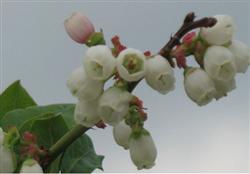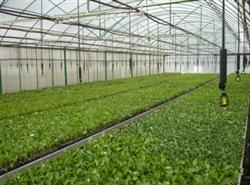How to harvest blueberry fruit?
How to harvest blueberries? Please guide 1, dwarf blueberry harvest dwarf blueberry fruit ripening is more consistent, the first ripe fruit generally does not fall off, can wait until all the fruit is ripe before harvest. In Changbai Mountain area of China, the fruit ripening time is in the middle and late July. The fruit of dwarf blueberry is small, so it is difficult to pick by hand, and the comb-shaped artificial harvester is the most frequently used and convenient. After the fruit is harvested, remove sundries such as branches, leaves or stones and put them into containers. Mechanical harvesting of dwarf blueberries is mostly used in the United States and Canada. The harvesting machine is also a large comb harvester, equipped with a shaking device, which swings up and down, left and right during harvest, harvests the fruit, and then transports the fruit to the cleaner with a conveyor belt. 2. The fruit ripening period of the same variety, the same tree and the same ear of high-clump blueberry is not completely the same, and the general harvest time can last 3-4 weeks, so the harvest should be harvested in batches. The fruit is usually picked every other week. When the fruit is sold fresh as raw food, the fruit is picked by hand. After harvest, put it into a plastic food box, then put it into a shallow plate, and transport it to the market for sale. Extrusion, exposure, wind and rain should be avoided as far as possible. In general, an adult labor force collects about 40kg every day. When picking by hand, it can be harvested and graded directly according to fruit size and maturity. In order to save labor, hand-held electric harvesters are used in the harvest of rabbit-eyed blueberries and tall blueberries in the United States. The harvester is heavy about 2.5kg, which is composed of electric vibration device and four protruding harvesting teeth, driven by dry battery. When working, the movable fruit receiver under the tree is placed under the tree, the four harvesting teeth of the harvester are deep into the trees, and the fruit branches are injected to start the power supply vibration for about 3 seconds. The use of this harvester requires the cooperation of 3 people, so that its working efficiency is equivalent to 2-3 times that of manual harvesting. The fruits need to be graded and packed before they are put on the market. The fruit should be harvested at the right time, not too early. When harvested prematurely, the fruit is small and the flavor is poor, which affects the fruit quality. But it should not be too late, especially the fresh fruit is sold far away, and the storage and transportation resistance will be reduced if harvested too late. Blueberries are ripe in the middle of summer, so be careful not to harvest them in the rain or immediately after the rain, so as not to cause mildew. 3. Due to the lack of labor resources in developed countries, mechanical harvesting has been paid more and more attention in the production of high-clump blueberries. The main principle of mechanical harvesting is vibrating fruit drop. A large mechanical harvester including vibrator, fruit receiver and conveyor belt device can harvest more than 0.5ha area in one hour, which is equivalent to the workload of 160people. Thus greatly reduce the cost. However, there are several problems in mechanical harvesting, one is the yield loss, it is estimated that the mechanical harvesting loses about 30% of the output compared with manual harvesting, the second is that the fruits harvested by machinery must go through hierarchical packaging procedures, and the third is that the early investment is relatively large. In our country, it is not suitable to use small area decentralized management, but mechanized harvesting should be considered in large area and intensive cultivation. 4. Fruit grading after harvest, after primary mechanical classification, it still contains stones, leaves, immature fruit, squeeze injury, crush injury and other fruits, which need to be further classified. The fruits were graded according to their maturity and size after harvest. The grading criteria of high-clump blueberries mainly include: berry pH 3.25-4.25; soluble sugar < 10%; total acid 0.3%-1.3%; sugar / acid ratio 10: 33; firmness enough to resist 170-180 rpm / s vibration; fruit size, diameter > 1cm; color does not reach the inherent blue indicating that it is not yet ripe, while the pigment content in the fruit is more than 0.5%, it is overripe. In practice, it is mainly classified according to fruit firmness, specific gravity and refraction. Grading according to specific gravity is the most commonly used method, which is based on two principles. One is to separate by air flow. The blueberry fruit is blown away through the air flow, such as twigs, leaves, dust and other light objects, while the ripe fruits and heavier heavy objects are cut off and go on to the next step of classification. The next grading is generally done manually. Another way is to use flow classification. The effect of water flow classification is better, but the disadvantage is that the appearance quality is affected by the loss of fruit powder. 5. In the packaging market, fresh blueberries are usually packed in non-toxic plastic boxes, with each box weighing 120g, or 500g. It is then packed in cartons for storage and transportation. Click to get more blueberry planting techniques click to get more fruit planting techniques
- Prev

How do blueberries blossom?
How do blueberries blossom? The flowers of blueberries are racemes. Inflorescences mostly lateral, sometimes terminal. Flowers solitary or twin in axils of leaves. Flower buds are generally borne at the top of branches. The flower buds germinated for 3-4 weeks in spring and then reached the full flowering stage. When the flower bud germinates, the leaf bud begins to grow, and the leaf bud only sprouts when it is in full bloom.
- Next

How do blueberries reproduce?
How do blueberries reproduce? Please introduce blueberry propagation methods are many, such as cuttage, seeding, ramets and other methods can be used. At present, blueberry cultivation in China is usually based on cuttage propagation methods, other methods such as seed seedling, rhizome cuttage, ramets and so on are also applied. In recent years, through species...
Related
- Moge, come on! The staff of the peasant association in the producing area of cantaloupe were frightened when the crowd gathered.
- Causes and Solutions of low Fruit setting rate of Apple
- Symptoms and control measures of passion fruit virus disease
- Fruit growing lesson: how do apple orchards keep high yields?
- Can you build orchards in the mountains? What are the pros and cons?
- How to manage the coloring period of Crisson grape?
- This paper introduces the processing technology of two kinds of fig products.
- How much is a month for retired teachers in rural areas by 2020?
- How can strawberry planting increase sugar content? We should pay attention to management in many aspects.
- What are the cultivation techniques on how to improve the yield of golden fruit?

